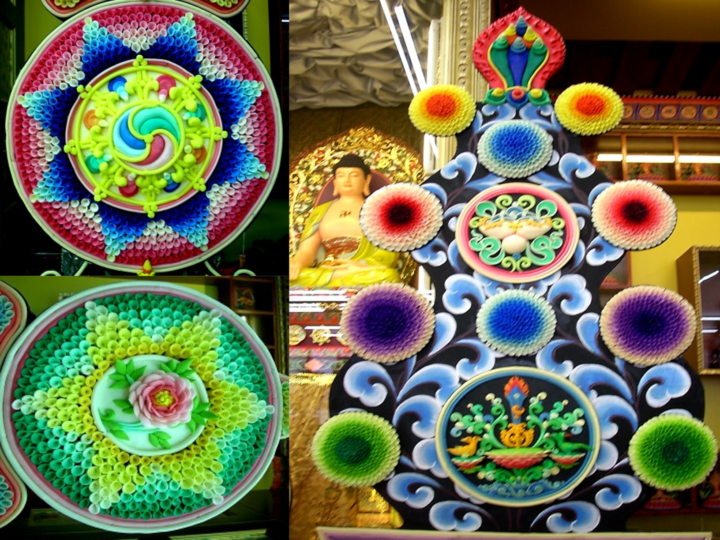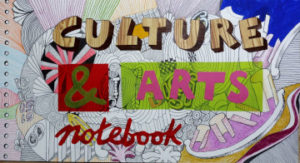SPIRITUALITY (Third of a Series)
by Genevieve Balance-Kupang
Creating mandalas is intentional, serial, imaginal, and relational. It offers a method, a process, and a potential for integrating unconscious dynamics into awareness and as an expression of one’s being and spirituality. It facilitates individuation, a Jungian term for becoming one’s authentic whole Self in relationship to the Transpersonal Power.
Mystical experiences, while uniquely personal, are similar across time. They are transformative moments resulting in significant personal shifts in understanding of self, relationships, faith, commonly held beliefs and societal constructs. Faith communities are challenged to grow in their capacity to recognize and nurture the personal, communal, social, and cultural nature of mystical experience. My personal experiences were validated vis-à-vis my co-researchers and here I saw an opportunity for their narratives to resonate with mine. This was significant.
This is the third in a series. In case you missed the first and second, here are the links:
https://staging1.pressenza.com/202 1/04/mandala-as-a-symbol-of-the-self-spirituality-and-wholeness/ https://staging1.pressenza.com/2021/04/the-phenomenon-of-mandala-making/
These articles on mandalas are the fruits of years of research, observations, and experiments. They are snippets of anecdotes and lived experiences from different religious backgrounds and places. Personally, I have observed that several of those I yearned, prayed for, written, and created on the mandalas were manifesting one after another. Some mandala ‘heartists” say the same, too. So, we offer our praise and thanks to the Supreme Artist who allowed us to discover the beauty of mandala-making.

Photo credit: Eule Rico Bonganay
I received feedback and delightful comments from those who read the first two articles on the mandala and I want to share some here. Our ever-supportive peace partner Byakko Shinko Kai (BSK), Japan, thru Stano has shared what he culled:
Thank you for sharing these beautifully expressed articles! Very inspiring, Infinite love. Caroline (UK)
Very nice to hear from Genie and her wonderful so inspiring mandalas, her ongoing search and research on their profound spiritual meaning,
Many thanks to her if you write back, and happy to know that she is well and holding the light of peace in the Philippines, Infinite gratitude, Nicole (France)
Thank you very much for sharing this artistic event with mandalas…they are so beautiful…congratulation…Infinite Love and Gratitude. Maria Caterina (Italy)
Thank you very much! These articles are very interesting and useful, the mandalas are beautiful! With Love, Sonoko (Italy)
Thank you. I have shared the importance of mandalas to every mythology student in Applied Cosmic Anthropology, but you are the one who understood its deep cosmic significance. Keep up the good work. I will wait for the next articles in the series. Felipe (Philippines)
These made my heart bounced with joy. I owe a lot from the BSK stakeholders from whom I first discovered the essence and art of creating mandalas.
Methodology
Qualitative research especially existential phenomenology was used where inquiry as an approach is useful for exploring and understanding the phenomenon of mandalas. As a philosophy and an approach to research, it allowed me to view the phenomenon as experienced by my co-researchers and accept that each person is unique and has his/her own reality.
Homogeneous purposeful sampling was used in the selection of my co-researchers, a sampling strategy in which I invited and requested well-meaning individuals based on membership of the JPIC movement, spiritual practices and promoters of health and wellness as their defining characteristics. The co-researchers were involved as spiritual practitioner, counselor, psychologist, interfaith volunteer, NGO and pastoral worker, peace and nonviolence advocates who have created mandalas and advocated their use for meditation, healing, peacemaking, et al. The selected co-researchers come from Australia, Nepal-Tibet, Philippines, Slovakia-Japan, and the United States.
Venerable Jamyang Pemba (a Buddhist monk from Nepal)
During the interview with the group of monks from India, Tibet, and Nepal who created the sand mandala which I shared in the first article, Ven. Jamyang was the one who could speak English. He posited that the mandala is “an ancient art tool and technique in expressing one’s spirituality… We monks create the mandala as another superb practice of meditation or mind cultivation. The process brings us further enlightenment, purification, healing, guidance in the journey and achievement of balance. One thing very important is for us to achieve the right actions in this life so that we will have a good life in the next life and be freed from sufferings…”

Another Buddhist artist Jamyang Khedup from Tibet created these flower-like mandalas from milk and butter which were offered in a ceremony to the Buddha with chanting, incense, and prayers. As a phenomenologist, in silence, with the Buddhist monks, moments were spent observing and reflecting deeply on the rich symbolism of the monks’ creation of the sand mandala. The monks expressed ‘we can transform our chaotic, egocentric world-environment into exalted wisdom and the perfected world of enlightened beings.’
As a phenomenologist, in silence, with the Buddhist monks, moments were spent observing and reflecting deeply on the rich symbolism of the monks’ creation of the sand mandala. The monks expressed ‘we can transform our chaotic, egocentric world-environment into exalted wisdom and the perfected world of enlightened beings.’
For posterity, I had been framing or laminating my own and my students’ mandala arts. But to the Buddhist monks, after hours and hours (even days or a week) of praying, meditating, and creating (in silence) the sand mandalas, they had a ritual of wiping out what they have painstakingly and intricately created. Ven. Jamyang explained “The whole ritual of dismantling symbolizes the principle of impermanence and non-attachment at the same time a new beginning as the colored sands is carefully collected and placed into the basin/jar to be sprinkled in a body of water like a river, around the house or structure, or around an altar. The flowing water carries the prayers and blessings of the mandala to the universe for purification, healing, and thanksgiving.”

The ritual of dismantling symbolizes the principle of impermanence, non-attachment, and new beginning.
Jenny Funston (Victoria, Australia)
Jenny is a kindred spirit, an educator, a peace advocate, and the Oceanic Coordinator at Byakko Shinko Kai Peace Organization. She works for this spiritual organization based in Japan and helps promulgate the message “May Peace Prevail on Earth.” Jenny shared that the “Mandala is a writing meditation. Mandalas have the potential to take a person into a deep meditative state or even just to allow a greater sense of peace and quiet to enter in the writing phase. We know from medical experiments that when a person goes more deeply into a quiet, relaxed state, all bodily systems also relax and can bring about deep healing on all sorts of levels, including mental, emotional, and physical. Of course, on a spiritual level, great changes can occur too. It is also a way for people to access greater peace within and subsequently radiates this peace into their everyday life.”

Every time I conduct a mandala workshop, I remember what my co-researchers have shared. I have learned a great deal from all of them and tend to repeat their words to my workshop participants like these words from Jenny Funston: “all things positive are contained within the mandala vessel. It becomes a container of positive essence.” Since 2012, Jenny has been very supportive of peace work through her words of affirmation, encouragement, and solidarity. I feel her spirit and her soul’s brightness every time I share the essence of mandala. She may not know this, but, every time, she connects, it uplifts my spirit to continue the mission of cultivating gratitude, spreading positivity, and healing all aspects of one’s being. Mandala-making for her denotes wholeness and completeness. BSK stakeholders mandala experiences including Jenny’s has inspired me to conduct workshops to universities like the University of Santo Toma among PhD students of psychology; among students and some employees of De La Salle Health and Medical Sciences Institute, the University of the Philippines in coordination with Ginhawa, and Sandiwa, doctoral students of Applied Cosmic Anthropology, basic education students in both public and private schools, and other organizations.
Mario “Toots” Fungo (+) [president of the Mandala Peace Arts Initiative, Inc., pastoral worker, peace volunteer from Bicol, Philippines]
Mario has been relentless and selfless in conducting and training the younger generations about the cosmic significance of creating mandalas in many institutions and organizations in the Philippines. He was instrumental in my search to find the answers to the following questions: 1.How may our experience in creating mandala as a symbol of being, spirituality, & wholeness be reflectively analyzed? 2.Why is it used as one of the tools for advocating for Justice, Peace, and Integrity of Creation (JPIC) and what meaning, and insights may be drawn from these experiences? Lastly, what implications may be drawn from the studies’ results to the JPIC programs and activities?

Mario Fungo (+), a valued and revered leader and peace advocate, trainer, and facilitator of mandala-making. The founder and president of the Mandala Peace Arts Initiative, Inc. passed away last March 22, 2020.
Mario embodied the true spirit of a peace advocate and a volunteer. He inspired many of us. He was one of the esteemed lay practitioners of interreligious dialogue in the Philippines. A generous soul, prayer warrior, and support, he elucidated that the “mandala is a path to peace. It is a means of elevating humanity’s consciousness and sending healing energy to nature.” It was from him that I learned how to simply utter and write these words of gratitude and integrate them in my mandala arts. “Thank you dear earth! I am so grateful to you for supporting my footsteps!” “Dear water, how wonderful you are! You make me feel refreshed every time I use you to wash my face and body!” “Thank you for the wonderful people in my life. They are always there showing their love and care.” “Today I am grateful for being alive.” “May peace prevail on Earth.” He went on to say that “words of gratitude integrated on the mandalas are especially powerful because gratitude is light itself. When the earth is infused with the light of gratitude, its strength revives, its suffering is lightened, and it can continue to provide love and support to humanity…”
The next article in the series will feature the insights and experiences of other co-researchers, including mine.
About the writer:
 Genevieve Balance Kupang (Genie) is an anthropologist, consultant, researcher, and advisor to individuals and organizations engaged in working for good governance, genuine leadership, justice, integrity of creation, peace, the indigenous peoples, preservation of cultures, and societal transformation processes. She is a peace educator, author, an interreligious dialogue practitioner, and resource person with a career in the academe and NGO.
Genevieve Balance Kupang (Genie) is an anthropologist, consultant, researcher, and advisor to individuals and organizations engaged in working for good governance, genuine leadership, justice, integrity of creation, peace, the indigenous peoples, preservation of cultures, and societal transformation processes. She is a peace educator, author, an interreligious dialogue practitioner, and resource person with a career in the academe and NGO.












